Path Planning of AS/RS Based on Cost Matrix and Improved Greedy Algorithm
Abstract
:1. Introduction
2. Problem Description and Model
2.1. Problem Description
2.2. Assumptions
- Taking a single task as a storage object; that is, the stacker can only deal with one task each time.
- The stacker moves at a constant speed in both horizontal and vertical directions.
- Since the time taken by the stacker to store or take out the goods from the shelf accounts for a small proportion of the total time, this time is ignored; that is, once the stacker moves to the target storage location, it is regarded as completing the storage task.
- All storage units on the shelf have the same length and width.
- The evaluation standard is the total time for the stacker to complete a series of access tasks.
2.3. Variable Table
2.4. Mathematical Model
3. Algorithm Design
3.1. Cost Matrix
3.2. Backtracking Algorithm for Solving Problems
3.3. Greedy Algorithm for Solving Problems
| Algorithm 1 Main program of greedy algorithm |
| 1: init_space() initialize table groups 2: while true: 3: smallest_info = seek_the_smallest() find the solution with the least cost value in the table group 4: r = blossom(smallest_info) update smallest_info and return the status code of the processing result 5: if r = 1: if smallest_info is the best solution 6: output smallest_info output results 7: break Exit the loop and end the program |
| Algorithm 2 Seek_the_smallest() |
| 1:for i in list_space: Take out all the elements in each table in turn. 2: Sort all the elements in ascending order according to cost value. 3: for i in list_space: 4: if there are solutions in the table: 5: if the cost value of the first solution is less than that of all known: record it 6: return smallest_info Return the solution corresponding to the minimum generation value. |
| Algorithm 3 Blossom () | |
| 1: | parameter: information of the solution corresponding to the minimum cost value, smallest_ info = [cost value c, layer number of solutions ] |
| 2: | if=: |
| 3: | return 1 |
| 4: | According to smallest_ info find the corresponding solution and write it down as smallest_ solution. |
| 5: | a solution solution_1 in the layer is generated, which satisfies solution_1[“value”] = small_solution[“value”] + value_1, and the row of value_1 is in small_ solution[“next_ available “]. |
| 6: | A solution_2 in the layer is generated, which satisfies the solution_2[“value”], replace the last element of small_solution [“value”] with a slightly larger value in the same column. |
| 7: | return 0 |
3.4. Proof of Algorithm Convergence to Optimal Solution
4. Simulation and Results
5. Conclusions
Author Contributions
Funding
Institutional Review Board Statement
Informed Consent Statement
Data Availability Statement
Conflicts of Interest
References
- Ding, L.; Chen, Y. Speed Optimization Design of Stacker in Automatic Stereoscopic Warehouse Based on PLC. J. Phys. Conf. Ser. 2020, 1678, 012021. [Google Scholar] [CrossRef]
- Lei, N.N.; Polytechnic, S. Research and application of automatic warehouse system. Mech. Eng. Autom. 2014, 3, 163–165. [Google Scholar]
- Wang, L.; Luo, C. A hybrid genetic tabu search algorithm for mobile robot to solve AS/RS path planning. Int. J. Robot. Autom. 2018, 33, 161–168. [Google Scholar] [CrossRef]
- Hino, H.; Kobayashi, Y.; Higashi, T.; Ota, J. Motion planning method for two stacker cranes in an automated storage and retrieval system. Int. J. Autom. Technol. 2012, 6, 792–801. [Google Scholar] [CrossRef]
- Gao, Q.; Lu, X.W. The complexity and on-line algorithm for automated storage and retrieval system with stacker cranes on one rail. J. Syst. Sci. Complex. 2016, 29, 1302–1319. [Google Scholar] [CrossRef]
- Lu, X.; Shi, H.Y.; Wang, L.; Li, D.W. Analytical travel time models for single and double command of multi-aisle automated storage and retrieval system. Int. J. Manuf. Technol. Manag. 2020, 34, 111–125. [Google Scholar] [CrossRef]
- Bottani, E.; Cecconi, M.; Vignali, G.; Montanari, R. Optimisation of storage allocation in order picking operations through a genetic algorithm. Int. J. Logist. Res. Appl. 2012, 15, 127–146. [Google Scholar] [CrossRef]
- Sun, J.; Zhang, F.; Lu, P.; Yee, J. Optimized modeling and opportunity cost analysis for overloaded interconnected dangerous goods in warehouse operations. Appl. Math. Model. 2021, 90, 151–164. [Google Scholar] [CrossRef]
- Li, S. Path planning of stacker for automated building materials warehouse based on the improved adaptive genetic algorithm. Appl. Mech. Mater. 2013, 325–326, 1475–1478. [Google Scholar] [CrossRef]
- Qiu, J. Research on production scheduling for coordination operation of stackers on monorail. In Proceedings of the 2020 IEEE International Conference on Power, Intelligent Computing and Systems, Shenyang, China, 28–30 July 2020; pp. 901–905. [Google Scholar]
- Thakur, N.; Han, C.Y. Multimodal approaches for indoor localization for ambient assisted living in smart homes. Information 2021, 12, 114. [Google Scholar] [CrossRef]
- Provas, K.R.; Koustav, D. Short term hydro-thermal scheduling using backtracking search algorithm. Int. J. Appl. Metaheuristic Comput. 2020, 11, 38–63. [Google Scholar]
- Yuan, S.; Fu, J.; Cui, F.; Zhang, X. Truck and Trailer Routing Problem Solving by a Backtracking Search Algorithm. J. Syst. Sci. Inf. 2020, 8, 253–272. [Google Scholar] [CrossRef]
- Shao, Z.; Shao, W.; Pi, D. Effective constructive heuristic and iterated greedy algorithm for distributed mixed blocking permutation flow-shop scheduling problem. Knowl. Based Syst. 2021, 221, 106959. [Google Scholar] [CrossRef]
- Chen, S.; Pan, Q.K.; Gao, L. Production scheduling for blocking flowshop in distributed environment using effective heuristics and iterated greedy algorithm. Robot. Comput.-Integr. Manuf. 2021, 71, 1–16. [Google Scholar] [CrossRef]
- Mao, J.-Y.; Pan, Q.-K.; Miao, Z.-H.; Gao, L. An effective multi-start iterated greedy algorithm to minimize makespan for the distributed permutation flowshop scheduling problem with preventive maintenance. Expert Syst. Appl. 2021, 169, 114495. [Google Scholar] [CrossRef]
- Zou, W.Q.; Pan, Q.K.; Tasgetiren, M.F. An effective iterated greedy algorithm for solving a multi-compartment AGV scheduling problem in a matrix manufacturing workshop. Appl. Soft Comput. 2021, 99, 1–17. [Google Scholar] [CrossRef]
- Fehmi, B.O.; Mujgan, S. Iterated greedy algorithms enhanced by hyper-heuristic-based learning for hybrid flexible flowshop scheduling problem with sequence dependent setup times: A case study at a manufacturing plant. Comput. Oper. Res. 2021, 125, 1–15. [Google Scholar]
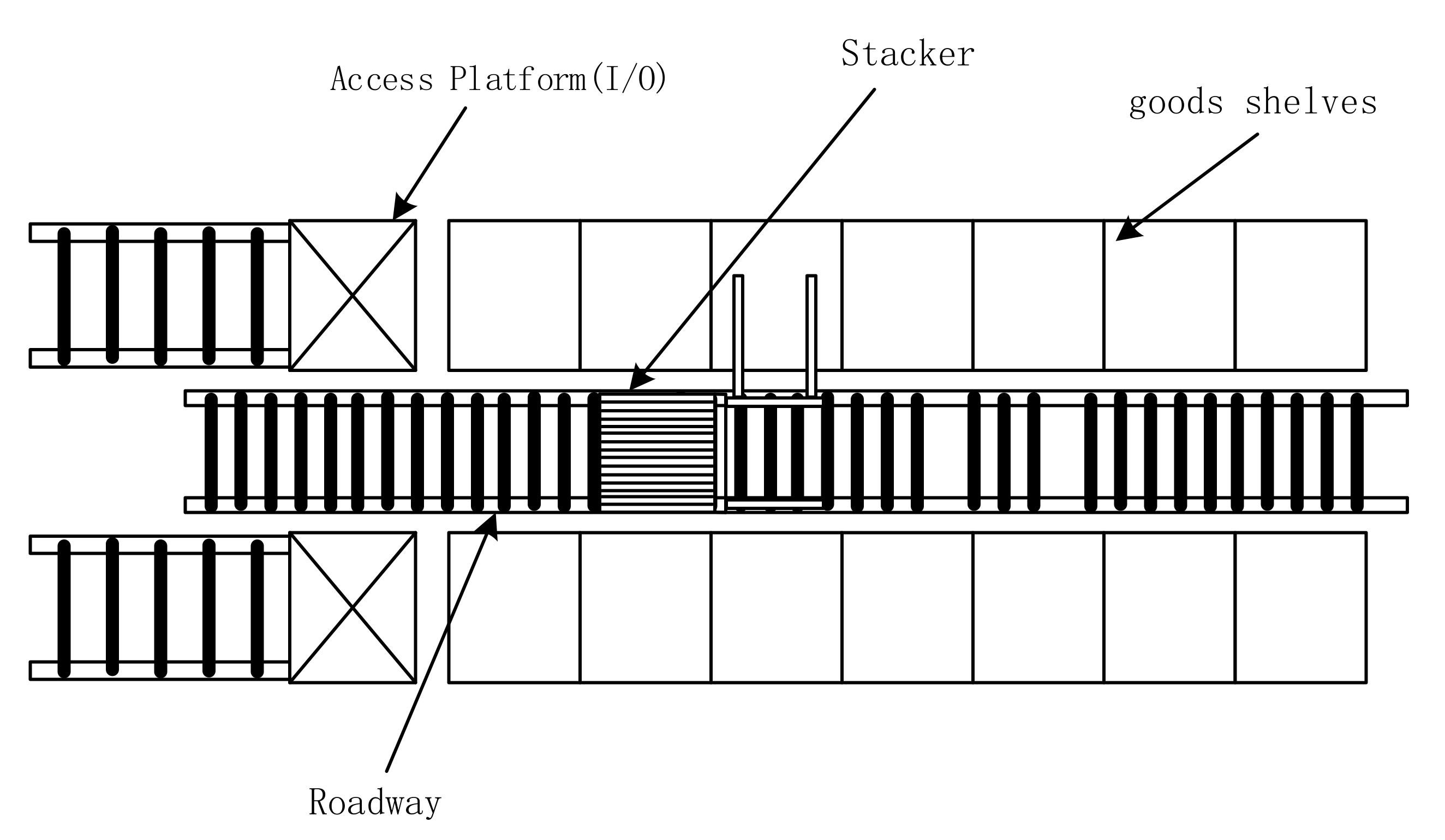




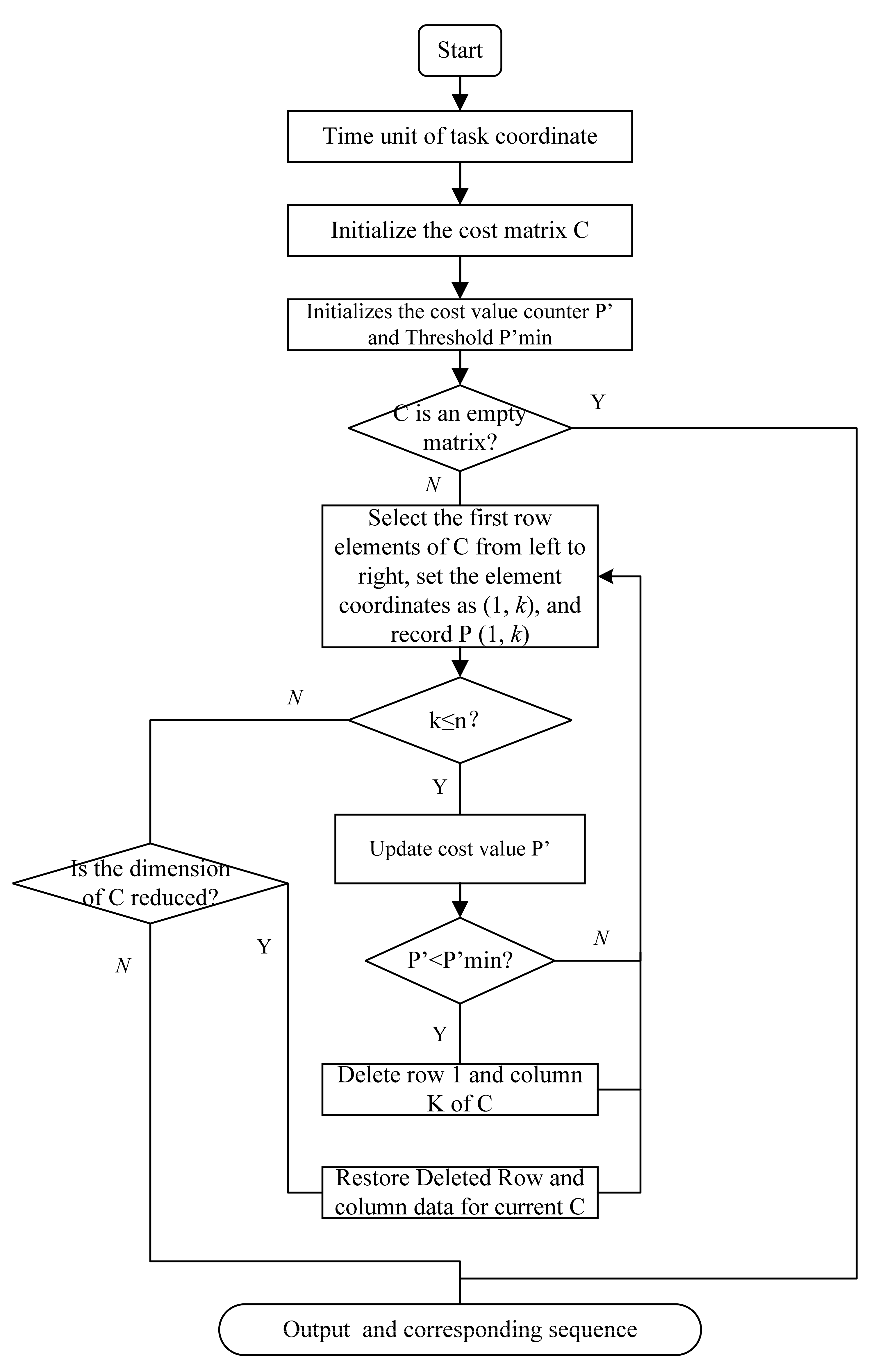

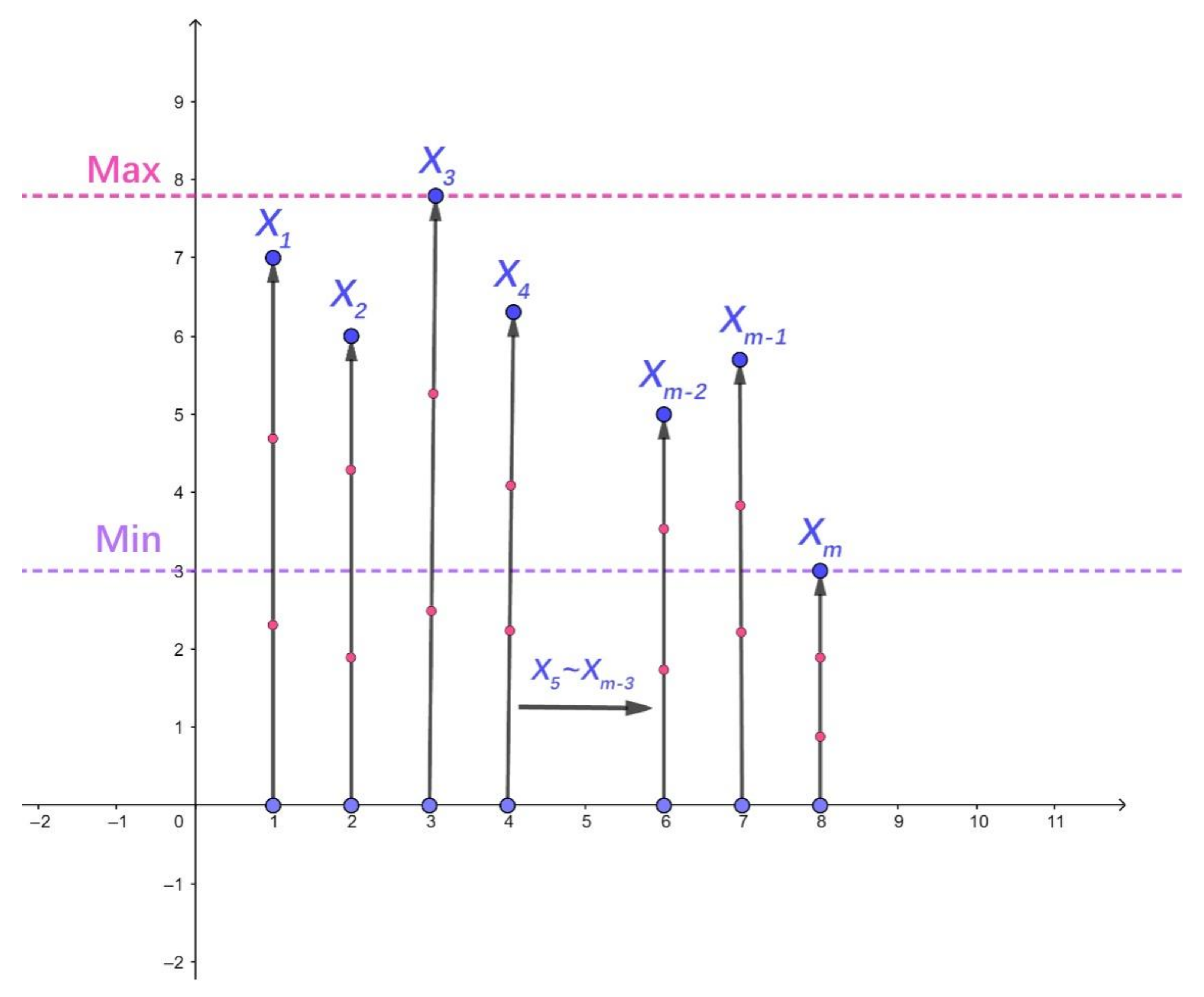
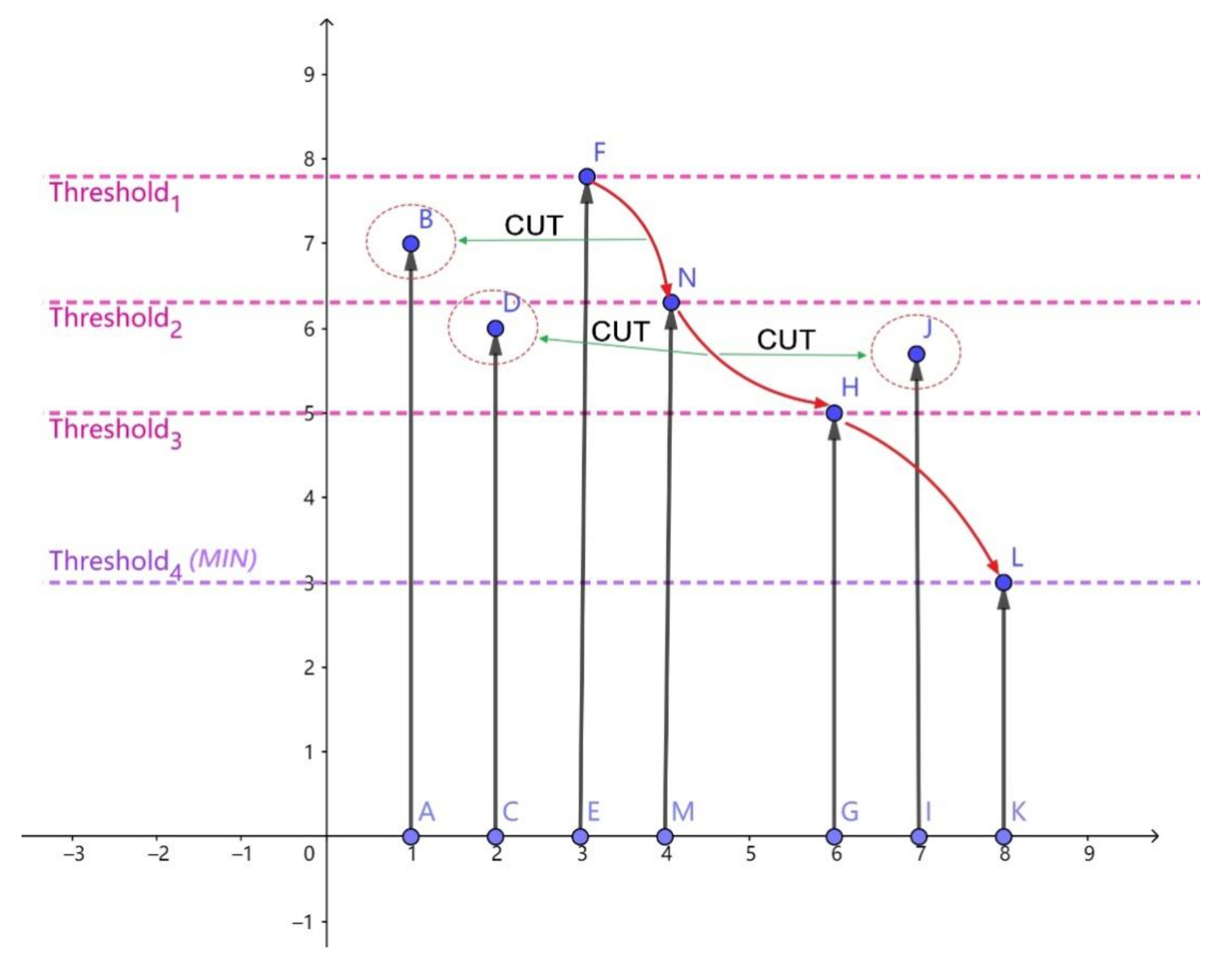

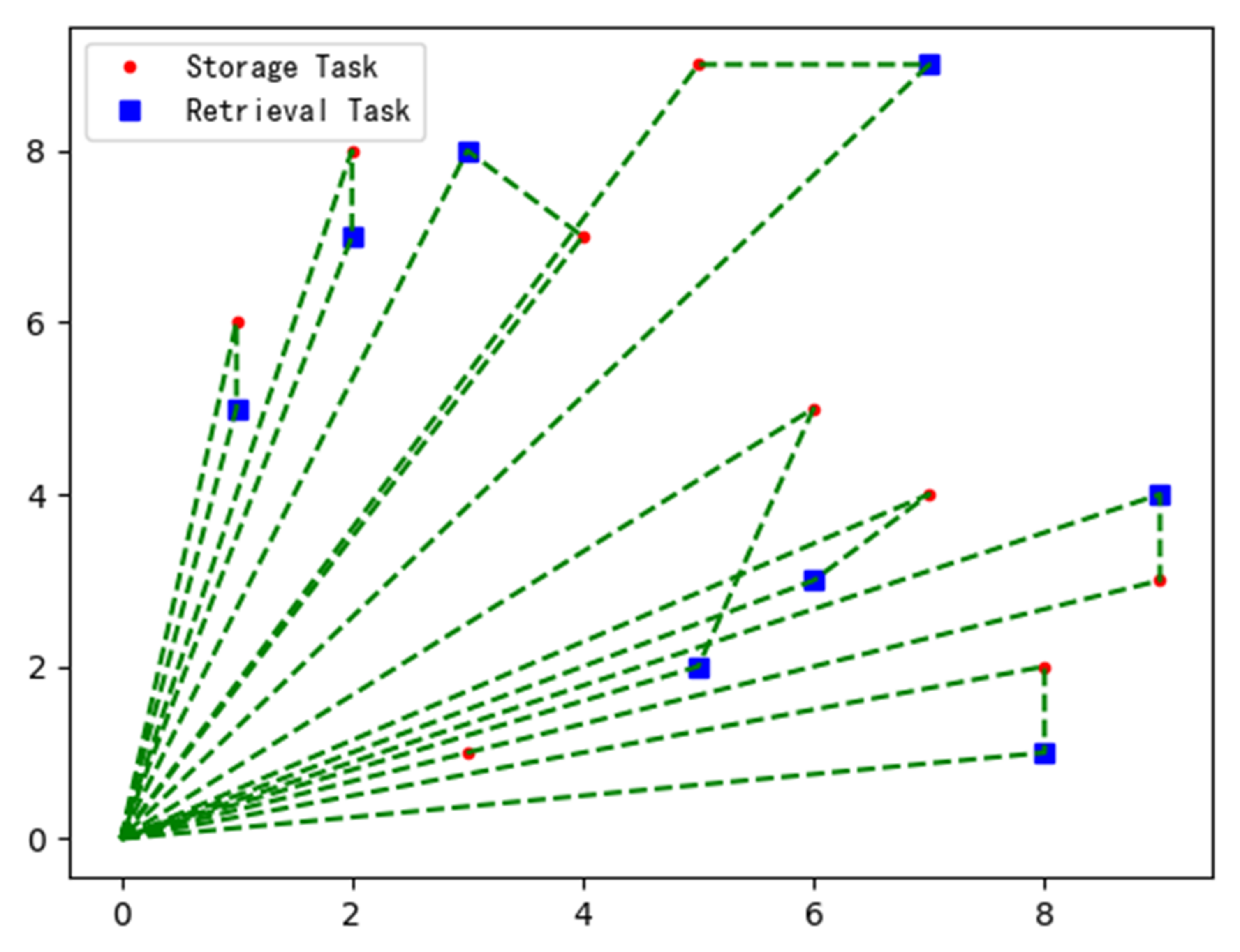

| Symbol | Explanation |
|---|---|
| Storage task | |
| Retrieval task | |
| Number of storage tasks | |
| Number of retrieval tasks | |
| Solution sequence model | |
| Size of solution space | |
| Horizontal moving speed of stacker | |
| Vertical moving speed of stacker | |
| Total time for stacker to complete task |
| Tasks | 1 | 2 | 3 | 4 | 5 | 6 | 7 | 8 | 9 |
|---|---|---|---|---|---|---|---|---|---|
| Storage | (8,2) | (6,5) | (7,4) | (5,9) | (2,8) | (4,7) | (1,6) | (9,3) | (3,1) |
| Retrieval | (1,5) | (9,4) | (2,7) | (6,3) | (5,2) | (8,1) | (3,8) | (7,9) |
| Algorithm | Time Consuming (s) | Number of Selecting Behaviors (Time) | Number of Traversing Complete Sequence |
|---|---|---|---|
| Exhaustive algorithm | 17.9118 | 623,530 | 362,880 |
| Backtracking algorithm | 0.5588 | 6172 | 16 |
| Self-locking greedy algorithm | 0.1059 | 932 | 1 |
| Parameters | Value |
|---|---|
| Population size | 30 |
| Iterations | 100 |
| Mutation probability | 0.1 |
| Crossover type | PMX |
| Selection methods | Tournament selection |
| Times | 1 | 2 | 3 | 4 | 5 | 6 | 7 | 8 | 9 | 10 |
|---|---|---|---|---|---|---|---|---|---|---|
| Q | 126 | 126 | 128 | 126 | 128 | 126 | 126 | 126 | 128 | 126 |
| R-q | 9 | 11 | 13 | 11 | 15 | 13 | 11 | 14 | 12 | 14 |
| T-all | 1.85 | 2.03 | 1.36 | 1.65 | 2.01 | 2.11 | 1.47 | 1.66 | 1.53 | 1.54 |
| T-q | 0.17 | 0.22 | 0.18 | 0.18 | 0.30 | 0.27 | 0.16 | 0.23 | 0.18 | 0.22 |
Publisher’s Note: MDPI stays neutral with regard to jurisdictional claims in published maps and institutional affiliations. |
© 2021 by the authors. Licensee MDPI, Basel, Switzerland. This article is an open access article distributed under the terms and conditions of the Creative Commons Attribution (CC BY) license (https://creativecommons.org/licenses/by/4.0/).
Share and Cite
Li, D.; Wang, L.; Geng, S.; Jiang, B. Path Planning of AS/RS Based on Cost Matrix and Improved Greedy Algorithm. Symmetry 2021, 13, 1483. https://doi.org/10.3390/sym13081483
Li D, Wang L, Geng S, Jiang B. Path Planning of AS/RS Based on Cost Matrix and Improved Greedy Algorithm. Symmetry. 2021; 13(8):1483. https://doi.org/10.3390/sym13081483
Chicago/Turabian StyleLi, Dongdong, Lei Wang, Sai Geng, and Benchi Jiang. 2021. "Path Planning of AS/RS Based on Cost Matrix and Improved Greedy Algorithm" Symmetry 13, no. 8: 1483. https://doi.org/10.3390/sym13081483
APA StyleLi, D., Wang, L., Geng, S., & Jiang, B. (2021). Path Planning of AS/RS Based on Cost Matrix and Improved Greedy Algorithm. Symmetry, 13(8), 1483. https://doi.org/10.3390/sym13081483





